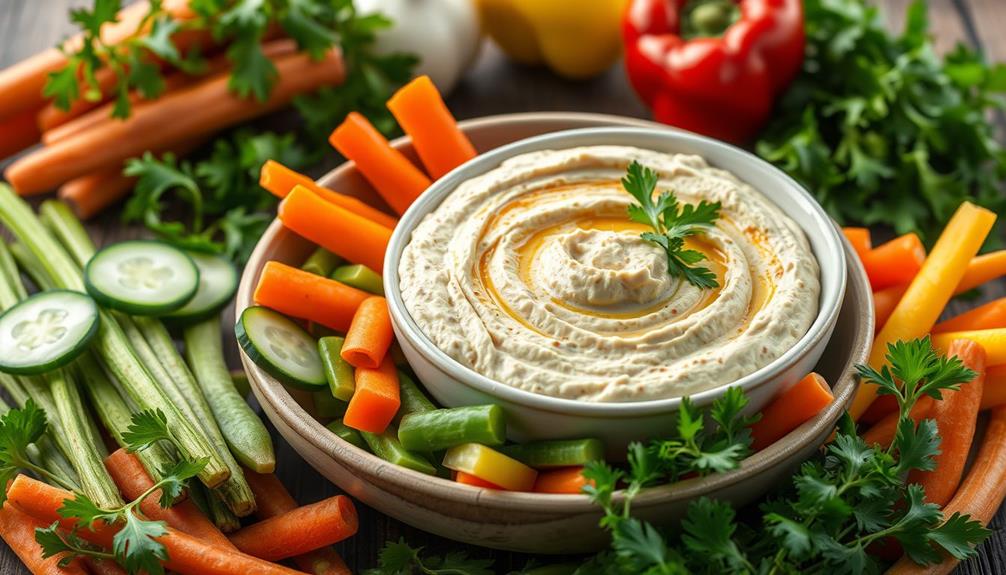Eating raw food can boost your health, but you need to be mindful of potential risks. A raw diet emphasizes fresh fruits, vegetables, nuts, and seeds, which are packed with vitamins, minerals, and antioxidants. However, you might face nutritional deficiencies, particularly in B12, iron, and omega-3s, if you don't plan well. Plus, consuming raw animal products carries a risk of foodborne illnesses. Balance is key; combining raw foods with some cooked options can enhance nutrient intake. By exploring various raw diet types, you can better tailor your approach for ideal health benefits ahead. Conducting a thorough raw food diet review can help you understand the potential benefits and drawbacks. It’s important to consult with a nutritionist or healthcare professional before making significant changes to your diet. They can provide valuable guidance in creating a well-rounded and safe meal plan. Additionally, listening to your body and being mindful of any changes in energy levels, digestion, and overall well-being can help you adjust your raw food diet to best suit your individual needs.
Key Takeaways
- Raw food diets promote nutrient intake from fruits, vegetables, nuts, and seeds, enhancing vitamins, minerals, and antioxidants.
- High fiber content in raw foods aids digestion, promotes satiety, and supports weight management.
- Risks of nutritional deficiencies, particularly in vitamin B12, calcium, and omega-3 fatty acids, should be considered.
- Consuming raw animal products increases the risk of foodborne illnesses from harmful bacteria and pathogens.
- Meal planning is essential for balanced nutrition, especially in raw vegan and vegetarian diets.
Overview of Raw Food Diet
The raw food diet is a fascinating approach to nutrition that emphasizes eating uncooked and unprocessed foods, primarily fruits, vegetables, nuts, seeds, and sprouted grains.
Originating in the mid-1970s, proponents of this diet believe that cooking destroys crucial nutrients and enzymes that promote health and longevity. The raw food diet typically prohibits heating food above 118°F (48°C).
Additionally, many raw food enthusiasts highlight the benefits of consuming foods rich in antioxidants, which can support overall health and may help prevent certain ailments, such as kidney stones, due to their nutrient-dense nature a potential health benefit.
There are three main types of raw food diets: the raw vegan diet, which excludes all animal products; the raw vegetarian diet, which includes raw dairy and eggs; and the raw omnivorous diet, which incorporates raw animal products.
Advocates claim that consuming uncooked foods can enhance your energy levels, improve digestion, and reduce the risk of chronic diseases, thanks to the high intake of nutrients and fiber.
However, you should be cautious, as the raw food diet can lead to nutritional deficiencies, particularly in vitamin B12, iron, and omega-3 fatty acids.
To maintain balanced nutrition, careful planning and potential supplementation are necessary. Additionally, consuming raw foods can increase your risk of foodborne illness, so it's crucial to choose fresh, high-quality ingredients.
Potential Health Benefits

Eating raw foods can boost your nutrient intake, thanks to the abundance of vitamins, minerals, and antioxidants found in fruits and vegetables.
This diet may also help you shed some pounds, as the high fiber content keeps you feeling full while consuming fewer calories.
Plus, by focusing on whole, unprocessed foods, you could lower your risk of chronic diseases like heart disease and diabetes.
Nutrient Density Advantages
Raw food diets offer impressive nutrient density advantages that can considerably boost your health. By focusing on fresh fruits and vegetables, these diets are rich in essential vitamins, minerals, and antioxidants, which are essential for overall well-being. Incorporating essential oils for health benefits can further enhance your wellness journey.
When you consume a variety of raw foods, you increase your intake of fiber, promoting better digestion and helping you feel full with fewer calories.
Studies show that a higher consumption of raw fruits and vegetables is linked to a lower risk of chronic diseases, such as heart disease, diabetes, and certain cancers. This protective effect largely stems from the nutrient density of raw foods, which retain water-soluble vitamins like vitamin C and many B vitamins that cooking can diminish.
Additionally, raw food diets encourage the consumption of natural enzymes found in uncooked foods. While the benefits of these enzymes for digestion and metabolism are debated among experts, many proponents believe they contribute positively to your health.
Weight Loss Support
Focusing on raw foods can greatly aid weight loss efforts. The raw food diet emphasizes fresh fruits and vegetables, which are low in calorie density and high in fiber. This combination helps you feel full while consuming fewer calories, promoting effective weight management.
Additionally, a proper diet that includes raw foods can mirror some benefits found in ultimate hamster care, such as boosting overall health and well-being. Here are three key benefits of a raw food diet for weight loss:
- High Fiber Content: Raw fruits and vegetables provide ample fiber, enhancing digestion and prolonging feelings of fullness, which can lead to reduced overall calorie consumption.
- Eliminating Processed Foods: By cutting out processed foods and added sugars, you're encouraged to make healthier food choices that boost diet quality and support weight control.
- Increased Energy Levels: Many people report feeling more energized on a raw food diet, which can motivate you to engage in more physical activity, further aiding your weight loss initiatives.
Incorporating these healthy foods into your daily routine can profoundly impact your weight loss journey, making it easier to maintain a healthy lifestyle and achieve your goals.
Chronic Disease Prevention
A diet rich in raw fruits and vegetables can greatly lower your risk of chronic diseases. By incorporating a raw food diet, you'll benefit from high nutrient and antioxidant content, which is vital for maintaining ideal health.
Additionally, essential oils for skin conditions can complement a healthy diet by promoting overall well-being. Studies show that individuals who follow this diet often have lower LDL cholesterol levels, which markedly reduces their risk of heart disease and other cardiovascular issues.
In addition, the increased fiber intake from raw foods enhances digestive health and promotes satiety, making it easier for you to manage your weight. This is critical because maintaining a healthy weight can further decrease the risk of obesity-related chronic diseases, such as diabetes.
Moreover, the vitamins and minerals found in plant-based foods contribute to improved immune function, helping you fend off illnesses more effectively. Research suggests that diets high in raw and plant-based options are associated with lower rates of certain cancers, highlighting the potential protective effects of these dietary choices.
Nutritional Risks and Considerations

Many people aren't aware of the nutritional risks associated with a raw food diet, which can lead to deficiencies in essential nutrients. If you're considering this lifestyle, it's important to recognize potential pitfalls, including:
- Vitamin B12 Deficiency: This vitamin is primarily found in animal products, making it challenging to obtain on a raw food diet. Additionally, incorporating a balanced diet is necessary to guarantee you're getting all necessary nutrients.
- Calcium and Bone Health: Insufficient calcium intake can result in lower bone mass, increasing osteoporosis risk over time.
- Omega-3 Fatty Acids: These essential fats are often lacking in a raw food diet, which can affect heart and brain health.
Furthermore, the restrictive nature of a raw food diet complicates achieving a balanced nutrient intake. You might struggle to get enough protein, impacting muscle maintenance and repair.
Plus, while raw foods retain water-soluble vitamins, cooking can enhance the bioavailability of certain nutrients that you could miss out on entirely. In addition, increased consumption of raw foods can elevate the risk of foodborne illnesses, especially from raw animal products, which can harbor harmful pathogens.
Awareness of these nutritional risks is critical for maintaining your health while following a raw food diet.
Dangers of Raw Animal Products

Consuming raw animal products poses significant dangers that shouldn't be overlooked. When you eat foods like raw meats, raw eggs, or unpasteurized dairy, you're exposing yourself to a higher risk of foodborne illnesses. These products can harbor harmful bacteria such as E. coli, Salmonella, and Listeria, which can lead to severe health issues.
In fact, the risks associated with these foods are similar to those of not taking proper precautions during outdoor activities, such as being aware of tick-borne diseases. For instance, raw eggs are notorious for carrying Salmonella, which can cause everything from mild stomach upset to serious illness, especially in vulnerable groups like pregnant women and the elderly.
Similarly, consuming raw meats and poultry can be extremely risky; they often contain harmful bacteria and parasites that are typically killed through proper cooking. Ignoring these risks could easily lead to food poisoning.
Unpasteurized dairy products also pose significant health risks, as they may contain pathogens responsible for severe gastrointestinal diseases. Nutrition experts often warn that the potential health risks associated with consuming raw animal products far outweigh any perceived benefits.
As a result, it's important to think carefully before including these foods in your diet, as the dangers can have lasting effects on your health.
Types of Raw Food Diets

When exploring raw food diets, you'll find several distinct options to evaluate.
The Raw Vegan Diet focuses solely on plant-based foods, which are known for their high fiber and low-calorie content, promoting weight loss and digestive health.
Meanwhile, the Raw Vegetarian Diet adds raw dairy and eggs for extra nutrients, benefiting from the natural enzymes present in these foods boosts immune system function.
If you're open to it, the Raw Omnivorous Diet includes both raw plants and animal products, but be cautious about food safety risks.
Raw Vegan Options
Exploring the world of raw vegan options opens up a vibrant array of plant-based foods that can nourish your body while adhering to a strict diet.
The raw vegan diet emphasizes uncooked plant-based foods, such as fruits, vegetables, nuts, seeds, and sprouted grains, typically not exceeding temperatures of 118°F. This approach promotes healthy eating, but it's important to be aware of potential nutrient deficiencies and how to manage them effectively with a well-structured plan, much like creating a budget for managing income and expenses.
Here are three key factors for your raw vegan journey:
- Vitamin B12: Since this vitamin is primarily found in animal products, you may need to think about supplements or fortified foods to meet your needs.
- Calcium and Omega-3s: These nutrients are vital for bone health and brain function. Incorporate sources like leafy greens, flaxseeds, and chia seeds.
- Food Safety Risks: While raw vegan diets avoid animal products, improper handling of uncooked plant-based foods can still pose food safety risks.
Raw Vegetarian Choices
A variety of raw vegetarian choices can enrich your diet while maintaining the principles of raw food consumption. The raw vegetarian diet includes nutrient-rich plant-based foods, alongside raw eggs and unprocessed dairy. This approach enhances your nutrient profile compared to a strictly raw vegan diet, offering benefits like high fiber from fruits and vegetables, along with essential proteins and fats.
Here's a glimpse of what you might include in your meals:
| Food Type | Nutritional Benefits |
|---|---|
| Raw Fruits | High fiber, vitamins, and antioxidants |
| Raw Vegetables | Nutrient-rich, low-calorie options |
| Raw Eggs | Protein, healthy fats, vitamin B12 |
| Unprocessed Dairy | Calcium, vitamin B12, probiotics |
| Sprouted Grains | Enhanced nutrients, easy digestion |
Preparation methods like soaking, sprouting, and dehydrating help increase the nutritional value while keeping the temperature below 118°F. With these options, you can enjoy a varied and balanced raw vegetarian diet, ensuring you get the essential nutrients your body needs.
Raw Omnivorous Diets
Raw omnivorous diets expand on the principles of raw vegetarianism by incorporating a broader range of uncooked foods, including raw animal products like meat, fish, dairy, and eggs.
This dietary approach allows you to enjoy a variety of nutrients while offering more protein sources than raw vegan or vegetarian options. However, it's essential to contemplate food safety risks, as raw animal products can harbor harmful bacteria like E. coli and Salmonella.
Additionally, just as employers conduct background checks to guarantee safety and compliance in hiring practices, individuals must also be diligent about the safety of the foods they consume to protect their health, especially when it comes to ensuring workplace safety and compliance.
To maintain a balanced intake of essential nutrients on a raw omnivorous diet, reflect on these tips:
- Include a variety of uncooked foods. Focus on fresh fruits, vegetables, nuts, seeds, and sprouted grains alongside your raw animal products.
- Plan your meals carefully. Make sure you're getting the right amount of vitamins and minerals, especially if you're consuming fewer cooked items.
- Stay informed about food safety. Understand the risks associated with raw animal products and take precautions to minimize exposure to harmful bacteria.
Expert Opinions on Sustainability

While many individuals may find the allure of a raw food diet appealing, experts caution that its long-term sustainability is often questionable.
Though you might experience short-term health benefits, such as lower body mass indices and cholesterol levels, the restrictive nature of raw food diets can lead to significant nutrient deficiencies. Crucial nutrients like vitamin B12 and omega-3 fatty acids are often lacking, which raises concerns about your overall health.
Additionally, similar to the financial considerations for elderly care, financial aid sources can be essential for those considering specialized diets, as the cost of maintaining a raw food diet can be high.
Nutritionists generally recommend a balanced approach, incorporating both raw and minimally cooked foods. This strategy not only guarantees you get adequate nutrient intake but also promotes sustainability in your eating habits.
A varied diet helps prevent boredom and non-compliance, making it easier to stick to your nutritional goals.
Experts stress the importance of dietary variety, suggesting that you focus on a wide range of whole foods. This way, you can enhance your nutrient intake while enjoying diverse flavors and textures.
Practical Tips for Beginners

Embracing a raw food diet can seem intimidating, but starting with small, manageable changes can make the journey enjoyable and sustainable. Focus on gradually incorporating raw foods into your meals, aiming for at least 50% raw content initially. This allows your body to adjust while you explore the benefits of a healthy diet.
Here are three practical tips to get you started:
- Invest in Kitchen Tools: Equip your kitchen with essential tools like a high-quality blender, food processor, and dehydrator. These will simplify meal preparation and enhance your raw food experience.
- Experiment with Raw Recipes: Keep your meals interesting by trying a variety of raw recipes, including smoothies, salads, and sprouted grains. This will help guarantee a balanced nutrient intake and keep you excited about your diet.
- Support Local Produce: Focus on seasonal and local produce to maximize flavor and nutrition while supporting your community. Fresh ingredients can greatly enhance your raw meals.
What You Can Eat

There's a diverse array of delicious foods you can enjoy on a raw food diet. This lifestyle primarily revolves around uncooked, unprocessed foods that are rich in nutrients. You can indulge in a variety of fruits, vegetables, nuts, seeds, and sprouted grains. Here's a quick reference table to help you navigate your options:
| Category | Examples | Nutritional Benefits |
|---|---|---|
| Fruits | Berries, avocados, bananas | High in vitamins and antioxidants |
| Vegetables | Leafy greens, cucumbers | Rich in fiber and minerals |
| Nuts | Almonds, walnuts | Healthy fats and protein |
| Seeds | Chia seeds, flaxseeds | Omega-3 fatty acids |
| Sprouted Grains | Quinoa, sprouted legumes | Enhanced digestibility |
Incorporating these foods into your diet can enhance your overall health. Remember, it's best to focus on organic and seasonal produce to maximize flavor and nutrient content. While some might add unpasteurized dairy or raw meats, be cautious about potential foodborne pathogens. Stick to whole, plant-based ingredients for a safer, satisfying raw food experience.
Frequently Asked Questions
Is Eating Raw Food Healthier?
When you consider if eating raw food's healthier, remember it offers high vitamins and antioxidants. However, you're also missing out on some cooked food benefits, like improved nutrient absorption. Balance is key for ideal health.
What Are the Negatives of the Raw Food Diet?
Imagine a garden, vibrant yet fragile. You might find nutrient deficiencies lurking among the leaves, irregular cycles hiding beneath the soil, and food safety risks creeping in. A balanced approach nurtures both health and energy.
What Does a Raw Food Diet Do to Your Body?
A raw food diet boosts your vitamin and antioxidant intake, improving energy and skin health. It aids digestion due to high fiber, but you might face nutrient deficiencies and increased risk of foodborne illnesses.
What Is the Healthiest Raw Food Diet?
The healthiest raw food diet emphasizes a variety of fruits, vegetables, nuts, and seeds. You'll benefit from nutrient density while minimizing risks. Just guarantee you're planning to avoid deficiencies in essential nutrients like B12 and iron.
Conclusion
Eating raw food can be a invigorating way to boost your health, but it's not without risks. While fresh fruits and vegetables can provide essential nutrients, raw animal products may expose you to harmful bacteria. It's important to strike a balance between embracing the vibrant flavors of raw ingredients and staying mindful of safety. As you explore this diet, remember that moderation and informed choices will help you enjoy the benefits without compromising your well-being.

















